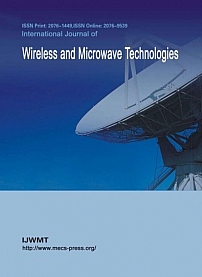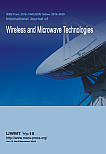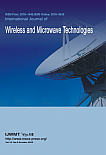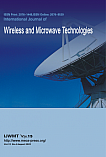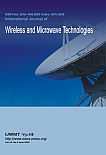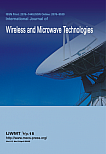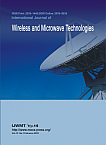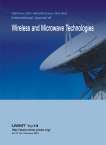International Journal of Wireless and Microwave Technologies @ijwmt
International Journal of Wireless and Microwave Technologies
Wireless and Microwave Technologies has been abstracted or indexed by several world class databases: Google Scholar, Microsoft Academic Search, Baidu Wenku, Open Access Articles, CNKI, GetInfo, WordCat, OneSearch, ZB MED, CrossRef, JournalTOCs, etc..
IJWMT is committed to bridge the theory and practice of wireless and microwave technologies. From innovative ideas to specific algorithms and full system implementations, IJWMT publishes original, peer-reviewed, and high quality articles in the areas of wireless and microwave technologies. IJWMT is a well-indexed scholarly journal and is indispensable reading and references for people working at the cutting edge of wireless and microwave technology applications.
The journal publishes original papers in the field of Wireless and Microwave Technologies which covers, but not limited to the following scope:
Wireless & Mobile Networking
Wireless Sensor Networks
Cognitive Radio Networks
Ad Hoc, Sensor and Mesh Networking
Next-Generation Networking and Internet
Wireless Network Security and Privacy
Networking and Information Security
Network Protocol and Congestion Control
QoS, Reliability & Performance Modeling
Mobility, Location and Handoff Management
Capacity, Throughput, Outage and Coverage
Multimedia in Wireless Networks
Optical Networks and Systems
Space-Time, MIMO and Adaptive Antennas
OFDM, CDMA and Spread Spectrum
Modulation, Coding and Diversity
Wireless Systems and Signal Processing (SDR, MIMO, UWB, etc.)
B3G/4G Systems, WiMAX, WLAN and WPAN
Channel Model and Characterization
Multi-Hop and Cooperative Communications
Interference Cancellation and MUD
Radio Resource Management and Allocation
Cognitive Radio and Software Defined Radio
Satellite & Space Communications
Multimedia Communications
Multiple Access Techniques
Optical Communications
Active Array Antennas and Components
Antenna Design, Modelling and Measurements
Antennas and Propagation for Wireless Systems
Applications and Standards (Mobile, Wireless, networks)
Characterization of Material Parameters
Circuit Design and Applications
Electromagnetic Compatibility
EM Field Theory and Numerical Techniques
Filters
Hybrid and Multi-Chip Modules
Linear and Non-linear CAD Techniques
Low Noise and Communication Receivers
Medical and Biological Effects
Meta-materials and Photonic Bandgap Structures
Microwave Measurements
Microwave Photonics
Modelling, Simulation and characterizations of devices and circuits
New and Emerging Technologies and Materials
Passive Components and Circuits
Power Amplifiers and Linearizers
Quality of Life / Medical Diagnosis and Imaging Systems
Radar and Homeland Security
Radar Applications
Radar Architecture and Systems
Radar Signal Processing and System Modelling
RFID and Sensors
RF-MEMS and MOEMS
Si-based Devices and IC Technologies
Modern Education and Computer Science Press
Выпуски журнала
Статьи журнала
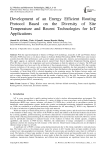
Статья научная
With the rapid development of Internet of Things (IoT) technology, researches in IoT and Wireless Sensor Networks (WSNs) has led to a very heavy reliance on Software Defined Networking (SDN). WSNs have some resource scarcities that affect their performance, such as power supply, processing units, memory, and communication capacity. This paper suggests an optimized routing protocol, named Future Search Algorithm-Temperature Routing protocol (FSA-TR) that is based on the temperature and recent technologies to find the optimal set of clusters. The SDN and Cloud technologies have been used in the architecture of the proposed protocol. A Multi-objective FSA that considers resource restrictions of the sensors, such as energy and communication capability, has been presented to identify the best solution. The temperature of the IoT sensors according to their distribution in the geographical has been considered. Accordingly, a Cluster Head (CH) is selected depending on the remaining energy, the distance between nodes, and environmental temperature. Finally, the experimental results showed an enhanced system performance of many features, such as energy dissipation, network lifetime and the number of packets sent to the sink. For instance, the network lifetime of the proposed protocol has been increased by approximately 36%, 27% and 20% compared to LEACH, SEP and optimized protocol PSO-C, consecutively.
Бесплатно
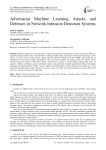
Adversarial Machine Learning Attacks and Defenses in Network Intrusion Detection Systems
Статья научная
Machine learning is now being used for applications ranging from healthcare to network security. However, machine learning models can be easily fooled into making mistakes using adversarial machine learning attacks. In this article, we focus on the evasion attacks against Network Intrusion Detection System (NIDS) and specifically on designing novel adversarial attacks and defenses using adversarial training. We propose white box attacks against intrusion detection systems. Under these attacks, the detection accuracy of model suffered significantly. Also, we propose a defense mechanism against adversarial attacks using adversarial sample augmented training. The biggest advantage of proposed defense is that it doesn’t require any modification to deep neural network architecture or any additional hyperparameter tuning. The gain in accuracy using very small adversarial samples for training deep neural network was however found to be significant.
Бесплатно
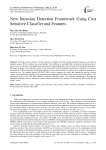
New Intrusion Detection Framework Using Cost Sensitive Classifier and Features
Статья научная
The huge increase amount of Cyber Attacks in computer networks emerge essential requirements of intrusion detection system, IDS to monitors the cybercriminals. The inefficient or unreliable IDS can decrease the performance of security services and today world applications and make the ongoing challenges on the Cyber Security and Data mining fields. This paper proposed a new detection system for the cyber-attacks with the ensemble classification of efficient cost sensitive decision trees, CSForest classifier and the least numbers of most relevant features are selected as the additional mechanism to reduce the cost. The standard dataset, NSL-KDD, IDS is used to appraise the results and compare the previous existing systems and state-of-the-art methods. The proposed system outperforms the other existing systems and can be public a new benchmark record for the NSL-KDD datasets of intrusion detection system. The proposed combination of choosing the appropriate classifier and the selection of perfect features mechanism can produce the cost-efficient IDS system for the security world.
Бесплатно
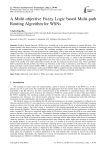
A Multi-objective Fuzzy Logic based Multi-path Routing Algorithm for WSNs
Статья научная
Wireless Sensor Networks (WSNs) have included one of the major challenges as energy efficiency. The optimal routing is the better solution for tackling the energy-efficiency problem as the energy is consumed with massive amount by the communication of a network. The clustering technique is the reliable data gathering algorithm for achieving energy-efficiency. The data transmit to the cluster head (CH) by each node that belonging to the cluster for clustered networks. The data transmission towards the BS or SINK is occurred once all data is received by CH from all member nodes. In multi-hop environments, the data transmission happens via other cluster-heads. It leads to the earlier death of CHs that are nearer to the SINK because of the heavy inter-cluster relay, i.e. called as hot-spot problem. The existing methods of unequal clustering approaches have been used to resolve this issue. The algorithms generate the clusters with smaller sizes while approaching towards the sink for reducing the intra-cluster relay. These algorithms didn’t consider the hotspot problem very effectively. Therefore, in this work, we introduce a multi-objective fuzzy logic based multi-path routing solution (MOFL-MPR) to address the above said problem. The popular clustering algorithms have been evaluated the performance results and the MOFL-MPR is outperformed the existing algorithms based on the obtained experimental results in terms of stable CH selection, energy efficiency and better data delivery.
Бесплатно
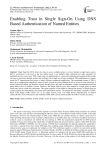
Enabling Trust in Single Sign-On Using DNS Based Authentication of Named Entities
Статья научная
Single Sign-On (SSO) allows the client to access multiple partner e-services through a single login session. SSO is convenient for the users as the user neither needs to set multiple login credentials nor login separately for individual services every time. SSO (single sign-on) authentication is a password-authentication approach that permits end users to login into multiple systems and websites with a single set of login credentials. SSO authentication is mainly useful for IT organizations that consist of many different commercial applications. The outstanding feature of SSO is that it gives organizations centralized control of their systems by giving different levels of access to each individual. It reduces password fatigue and increases security because users only need to remember a single username/password that grants them access to multiple systems. However, the Single Sign-on poses risks related to a single point of attack which may lead to a path for cybercrimes. This paper proposes a trust model to increase the security of Single Sign-on systems against the vulnerabilities discussed in the subsequent sections. The proposed Trust model is named as DANE-based Trust Plugin (DTP) which acts as an added security layer over DNS Based Authentication of Named entities(DANE). The DTP proposes the modified SAML XML schema which enables the DTP to counter the attacks.
Бесплатно

